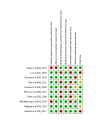Behavioral Therapy-Based Digital Interventions for Treating Osteoarthritis: Systematic Review and Meta-Analysis
- PMID: 40106814
- PMCID: PMC11966084
- DOI: 10.2196/56227
Behavioral Therapy-Based Digital Interventions for Treating Osteoarthritis: Systematic Review and Meta-Analysis
Abstract
Background: Osteoarthritis (OA) is characterized by pain, functional impairments, muscle weakness, and joint stiffness. Since OA heightens reliance on heath care resources and exacerbates socioeconomic burden, remote OA rehabilitation using digital technologies is rapidly evolving.
Objective: The aim of this study was to analyze the efficacy of behavioral therapy-based digital interventions for patients with OA.
Methods: This study is a systematic review of randomized controlled trials (RCTs) that assessed the effects of behavioral therapy-based digital intervention tools for OA. These RCTs were searched from inception to June 2023 in the Web of Science, Embase, Cochrane Library, Ovid, and PubMed databases.
Results: Ten eligible RCTs comprising 1895 patients with OA were included. Digital tools based on either cognitive behavioral therapy (CBT) or behavior change technique (BCT) were investigated. All studies demonstrated low-to-moderate effects on pain reduction in the short term (standardized mean difference [SMD] -0.20, 95% CI -0.35 to -0.05). Six studies reported improvement in physical function (SMD -0.20, 95% CI -0.41 to 0.00), and 5 confirmed increased pain self-efficacy (SMD 0.22, 95% CI 0.02-0.42). In subgroup analysis, compared with CBT, BCT-based digital interventions demonstrated their effects on pain reduction (SMD -0.25, 95% CI -0.49 to 0.00) and physical function (SMD -0.26, 95% CI -0.54 to -0.01) in the short term. In addition, physiotherapist involvement in treatment had a positive effect on pain control (SMD -0.14, 95% CI -0.27 to -0.02). Furthermore, web-based digital tools improved physical function in the short term (SMD -0.28, 95% CI -0.54 to -0.01).
Conclusions: Moderate- and low-quality evidence supported that behavioral therapy-based digital tools improved pain intensity, physical function, and self-efficacy in the short term. However, affective interactions between patients and professionals may affect the clinical outcomes.
Trial registration: PROSPERO CRD42023430716; https://tinyurl.com/yc49vzyy.
Keywords: behavioral therapy; digital intervention; impairment; meta-analysis; osteoarthritis; pain; pain reduction; patient; psychotherapy-based digital intervention; quality of life; socioeconomic burden; systematic review; treatment.
©Beiyao Zhu, Dian Zhu, Xiao'ao Xue, Hongyi Yang, Shurong Zhang. Originally published in the Journal of Medical Internet Research (https://www.jmir.org), 19.03.2025.
Conflict of interest statement
Conflicts of Interest: None declared.
Figures









Similar articles
-
Cognitive-behavioural treatment for subacute and chronic neck pain.Cochrane Database Syst Rev. 2015 May 26;2015(5):CD010664. doi: 10.1002/14651858.CD010664.pub2. Cochrane Database Syst Rev. 2015. PMID: 26006174 Free PMC article.
-
Exercise for osteoarthritis of the knee.Cochrane Database Syst Rev. 2015 Jan 9;1(1):CD004376. doi: 10.1002/14651858.CD004376.pub3. Cochrane Database Syst Rev. 2015. Update in: Cochrane Database Syst Rev. 2024 Dec 3;12:CD004376. doi: 10.1002/14651858.CD004376.pub4. PMID: 25569281 Free PMC article. Updated.
-
Interventions for treating persistent pain in survivors of torture.Cochrane Database Syst Rev. 2017 Aug 18;8(8):CD012051. doi: 10.1002/14651858.CD012051.pub2. Cochrane Database Syst Rev. 2017. PMID: 28820231 Free PMC article.
-
Exercise interventions and patient beliefs for people with hip, knee or hip and knee osteoarthritis: a mixed methods review.Cochrane Database Syst Rev. 2018 Apr 17;4(4):CD010842. doi: 10.1002/14651858.CD010842.pub2. Cochrane Database Syst Rev. 2018. PMID: 29664187 Free PMC article.
-
Exercise for hand osteoarthritis.Cochrane Database Syst Rev. 2017 Jan 31;1(1):CD010388. doi: 10.1002/14651858.CD010388.pub2. Cochrane Database Syst Rev. 2017. PMID: 28141914 Free PMC article.
Cited by
-
Digital Behavior Change Interventions to Promote Physical Activity and Reduce Sedentary Behavior Among Survivors of Breast Cancer: Systematic Review and Meta-Analysis of Randomized Controlled Trials.J Med Internet Res. 2025 Jun 19;27:e65278. doi: 10.2196/65278. J Med Internet Res. 2025. PMID: 40537089 Free PMC article.
References
-
- Allen K, Thoma L, Golightly Y. Epidemiology of osteoarthritis. Osteoarthritis Cartilage. 2022 Feb;30(2):184–195. doi: 10.1016/j.joca.2021.04.020. https://linkinghub.elsevier.com/retrieve/pii/S1063-4584(21)00886-4 S1063-4584(21)00886-4 - DOI - PMC - PubMed
-
- Quicke J, Conaghan P, Corp N, Peat G. Osteoarthritis Cartilage. 2022 Feb;30(2):196–206. doi: 10.1016/j.joca.2021.10.003. https://linkinghub.elsevier.com/retrieve/pii/S1063-4584(21)00934-1 S1063-4584(21)00934-1 - DOI - PubMed
Publication types
MeSH terms
LinkOut - more resources
Full Text Sources
Medical

